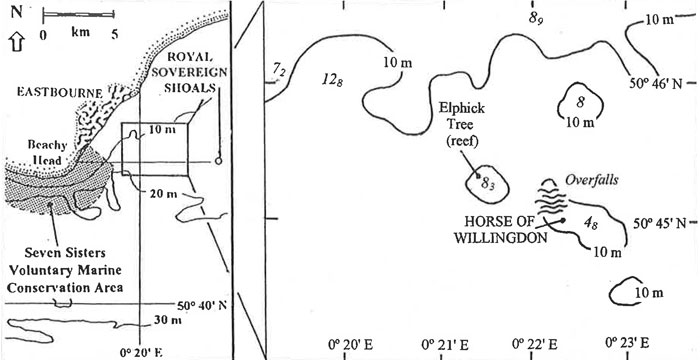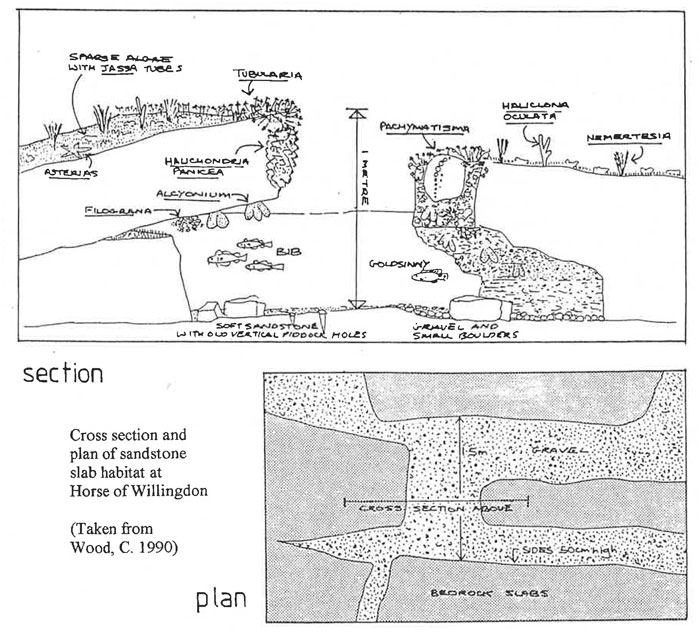< Previous Citation Next Citation >
SUSSEX MARINE SITES OF NATURE CONSERVATION IMPORTANCE
| Site: The Horse of Willingdon reef | Ref. No. 24 | ||||||
| Location: 8 km E of Eastbourne | Other conservation designation?: No |
||||||
| Lat./Long. position of centre of site: 50° 44' 87" N 0° 22' 31" E |
OS grid ref. of centre of site: TV 673 969 |
Author: Robert Irving |
|||||
| Sea bed type: Sandstone bedrock and boulder slabs. |
Depth range (below chart datum): 5-14 m |
Date identified: June 2001 |
|||||
Summary
The Horse of Willingdon reef is one of a number of subtidal sandstone reefs which lie scattered between The Pound at Eastbourne and the Royal Sovereign Shoals, some 12 km offshore. They include Elphick Tree, Long Shoal and the Royal Sovereign Shoals themselves, and a little further to the south, Southern Head close to the Royal Sovereign light tower. These constitute the easternmost sandstone reefs in the Channel, with an associated rich and diverse flora and fauna.
Biological Description
The Horse of Willingdon reef (origin of name uncertain) lies approximately 6 km east of Eastbourne. It is about l km in length (running NW/SE) and rises from a surrounding seabed of 14 m to 5 m depth BCD. The reef consists of sandstone bedrock and boulders, with patches of cobbles, pebbles and mixed sediment in between. The bedrock is clearly liable to fracturing (a phenomenon reported from other subtidal sandstone reefs off Sussex), described by a recorder as "irregular vertical fissuring giving an effect like crazy paving". Elsewhere the bedrock may form horizontal ledges with overhangs, or have irregular gullies up to 1 m deep in between large angular blocks.
The upward-facing surfaces of the shallowest parts of the reef have sparse foliose red algae present, with sponges dominating the sloping and vertical surfaces (in places providing over 75% cover). The purse sponges Grantia compressa and Scypha ciliata, and the elephant's ear sponge Pachymatisma johnstonia have been recorded from here, though they have not been recorded from the subtidal chalk reefs off Sussex. In some areas, surfaces are completely covered by mussels Mytilus edulis (both juveniles and adults), the shells of the larger ones being colonised by encrusting bryozoans. There are often large numbers of common starfish Asterias rubens also present. Silting is evident on ledges and horizontal surfaces. Other commonly encountered species include dead man's fingers Alcyonium digitatum, white anemones Actinothoe sphyrodeta, hydroids including Nemertesia antennina, barnacles and hornwrack Flustra foliacea. Tucked away in holes are edible crabs Cancer pagurus and velvet swimming crabs Necora puber. There are often shoals of small bib Trisopterus luscus present, as well as solitary goldsinny Ctenolabrus rupestris. On areas of mixed sediment are found short chains of slipper limpets Crepidula fornicata, dahlia anemones Urticina felina, gobies, dragonets Callionymus lyra, tompot blennies Parablennius gattorugine and occasional leopard-spotted gobies Thorogobius ephippiatus.
Justification
There are relatively few offshore rocky reefs in the eastern English Channel, with most being outcrops of chalk rather than of harder sandstone. The high nature conservation interest in these sandstone reefs is reflected in the fact that several are now marine SNCis: the Royal Sovereign Shoals (ref. no. 12), Kingmere Rocks off Littlehampton (ref. no. 16) and The Waldrons off Bognor (ref. no. 5).
References:Irving, R. A. 1999. Report of the Sussex Seasearch Project, 1992-1998 Sussex SEASEARCH Project, English Nature, Lewes, and Brighton & Hove Council, Brighton |
|||||||
| Sussex SEASEARCH dive nos.: 715/12-15, 52, 53, 55 & 59-62 | |||||||
| SeasearchSandstoneReefsSurveyNums: 4 | |||||||
Site Location

Diagrammatic representation of site: The Horse of Willingdon reef


:Link to this page
Copyright Sussex Biodiversity Records Centre © 2025